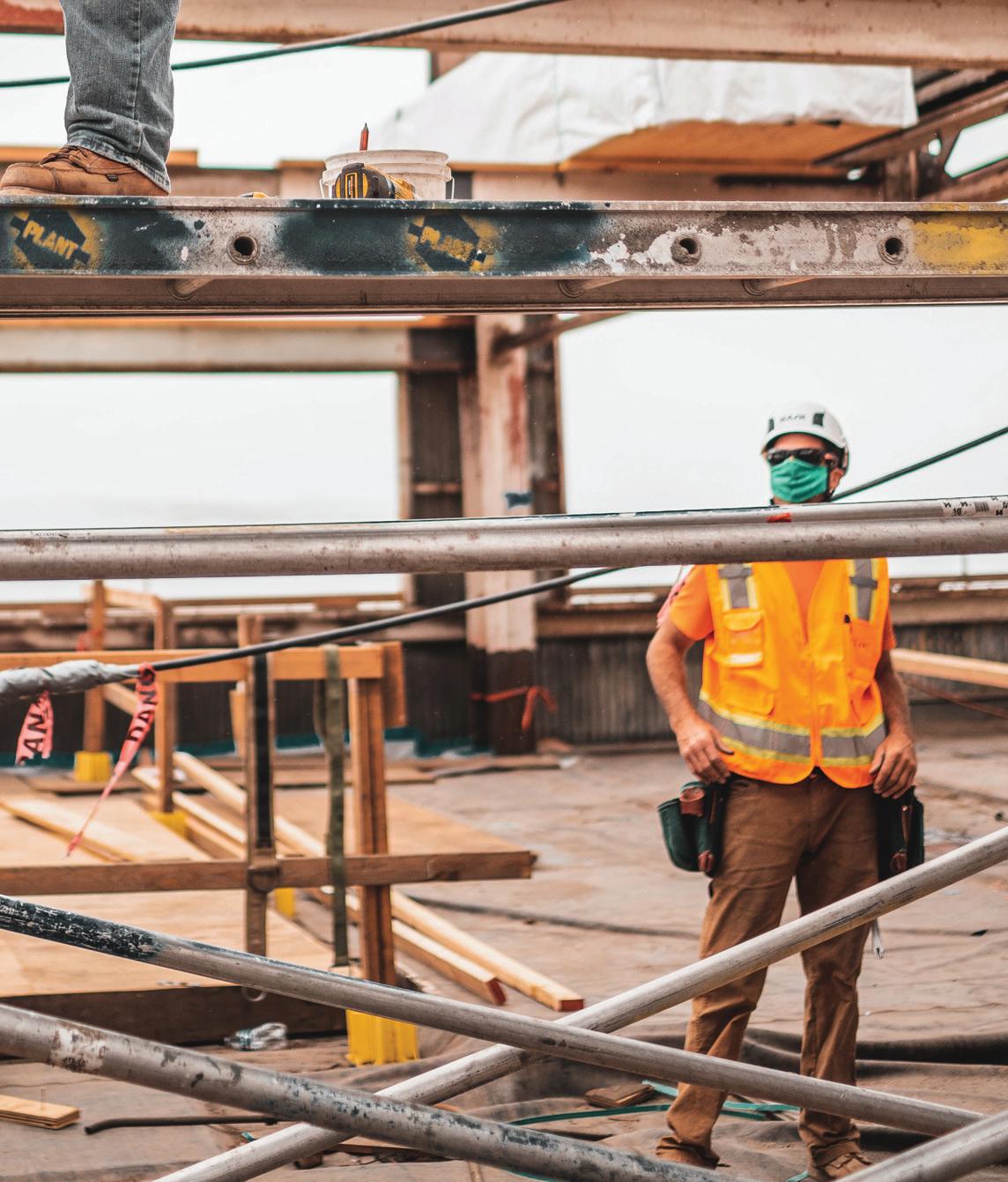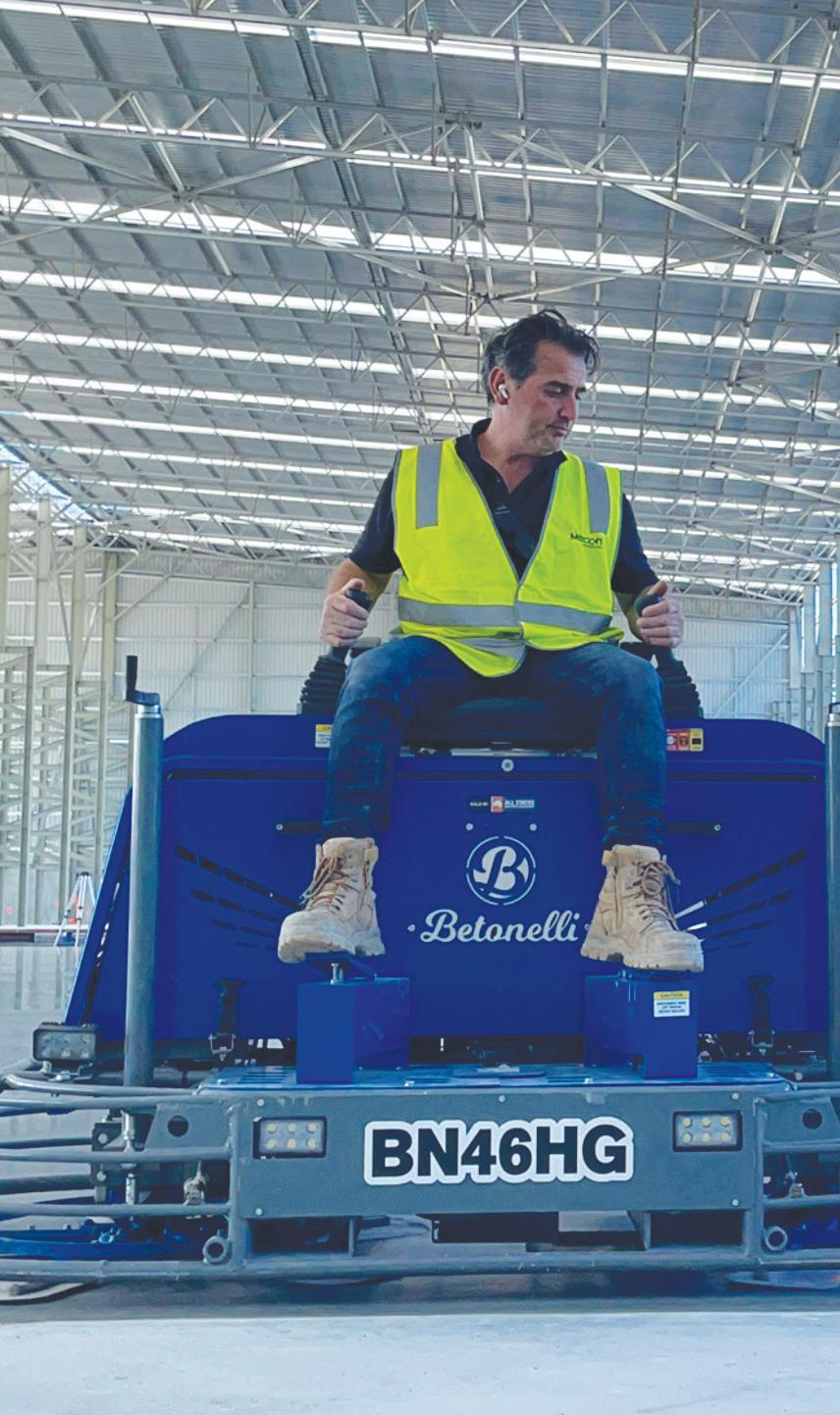
6 minute read
Safety trends . . . . . . . . . . . . . . . . . . . . . . . . . . . . . . . . . . . . . . . . 24
(unstable) when the hopper and / or drum is full and should not be transported in this state. Always ensure that the mixer is level when used. Hopper: The hopper is used to pour the mix into by means of wheelbarrows or manually. The hopper is tilted hydraulically or mechanically such to pour the cement, stone etc. into the drum. Always ensure enough space to operate (lift) the hopper with safe clearances. Engine / motor compartment: The driving force – the electrical motor or engine - is located in the compartment. The motor/ engine and the drivetrain to the drum, and hydraulics when fitted, must be checked and maintained before use. Control panel: The control panel contains the start/stop of the mixer (rotation) hydraulic or hopper control.
THE CONCRETE MIX
Advertisement
Mortar: Mortar will be Type M and shall conform to (Standard Specification for Aggregate for Masonry Mortar) ASTM C270. Type M Mortar will have proportions of one part Portland cement, a quarter part hydrated lime, and three and a half parts sand by volume. It will be freshly prepared and uniformly mixed and be of spreadable, workable consistency. Mortar should be re-tempered with water as required to maintain high plasticity, re-tempering on mortar and the mortar worked into the water. Do not use any mortar which is unused after one and a half hours from the initial mixing time. After all ingredients are in the batch mixer, they must be mechanically mixed for not less than three minutes. It is prohibited to use fire clay, rock dust, dirt and other deleterious materials in mortar. Sand for mortar must conform to ASTM C144. Aggregate: For the purpose that aggregates are used for support, infill, and embellishment, they need to undergo special, complex treatment. Aggregates deposits quarried across the world vary considerably from a geological point of view. The choice of deposits to be quarried is based on a compromise between proximity to consumption centres, the impact of each site on the environment and the quality of the aggregates. There are three major sources of supply: unconsolidated or loose rock – sand and alluvial materials; solid rock – limestone and hard rock or crushed volcanic rock; and recycled materials. Because of the growing shortage of deposits such as alluvial aggregates that used to be in riverbeds but begun to run out, the quarrying of solid rock has increasingly offset that of unconsolidated rock. All aggregate for mortar and grout must be well graded, clean, free of injurious amounts of dust, lumps, shale, alkali, surface coating, organic matter and sharp. Grout: Grout must have a minimum strength of 2 000 psi and must conform to ASTM C476. Fine grout must be proportional by volume of one part Portland cement and two and a quarter to three parts sand. Course grout must consist of one part Portland cement, two and a quarter to three parts of sand, and one to two parts coarse aggregate. It must be proportioned by volume. If the minimum strength is more than 2 000 psi, laboratory design mixes are required and acceptable in lieu of the above proportions. Aggregate for masonry grout must conform to ASTM C404. Admixtures: The use of admixtures will only be permitted in mortar or grout if approved by the engineer. Lime: Quick lime must conform to ASTM C5, and Hydrated lime must conform to ASTM C207. Water: Water must come from domestic supply and must be free of deleterious quantities of acids, alkalis, and organic materials.
SAFE WORK PROCEDURE
• Allow enough safe space between mixer and persons, machines, buildings etc • The area between drum and frame must be guarded • When transporting a mixer down an incline shaft a solid draw bar must be fitted, and great care must be taken as the mixer weights almost 1.5 ton • A concrete mixer can be unstable during operation and transport as its centre point of gravity is low • Do not overload the drum: normal capacity is around 600 litre and the drum will overflow if overloaded • Only authorised persons must operate the mixer as any other person does not know how to safely operate the mixer • Do not leave a working mixer unattended • Secure/ remove the hopper when transported • Secure its wheels so that the mixer does not move when operated • Ensure proximity hazards are checked out for dangerous cases, electrical, building site, ground conditions and the like • Ensure the electrical cable and plug, if applicable, is sound and safe • Do not try and alter the direction of rotation when the drum is in motion • Use all required personal protective equipment (PPE) • Ensure the mixer is properly lashed and chocked when transported. n
How to establish a concrete flooring business
By Eamonn Ryan
Concrete Trends interviews Australia-based Mario Florio, Director of the global firm All States Concrete Equipment.

Mario Florio, Director, All States Concrete Equipment.
In the next year and a half, All States Concrete Equipment based in Australia aims to achieve the milestone of 80% of its products being manufactured in-house in Australia.
The corporate strategy of All States is to get its brand globally known, says. “Part of our brand is to ‘concrete the world’. We want to be the best leaders in the market with anything that we do with concreting, including training, consulting – in every aspect of the business, we want to be number one.
“We have big expansion plans: we’ve already covered all Southeast Asia, the Middle East, South Africa, New Zealand and Australia, with our next target being America, which we’re working on right now.”
In addition to manufacturing its own products in-house, All States Concrete Equipment is the distributor of Ligchine equipment in Africa, the Middle East, Asia, Australia and New Zealand. Florio explains that Ligchine designs and manufactures highly reliable laser-guided screeds using cutting-edge technology to automate the process of flat finishing concrete. Ligchine equipment is essential to the construction of every structure, building, warehouse or facility that requires a flat floor. Ligchine’s product portfolio is comprised of a full line of high-performance boom-operated screeds and a new revolutionary drive-in machine that offers the greatest mobility and highest flatness numbers ever achieved by a drive-in machine. All machines can be custom-configured to operate with multiple machine control systems including laser, GPS (satellite) and LPS (robotic).
“This is a tough market that you have to be constantly working on at. The Asian market is like Africa in that they won’t buy the most expensive machines - but they’re changing right now as we speak as contractors seek to grow.”
He describes the first baby steps any contractor has to take in making the leap to automating flooring: “They’ve got to have a team with adequate knowledge of, let’s say, flat floors. That’s the point at which we come in to show them how they can do it better with the systems we implement.
“We’re mainly in the construction of warehouse floors using mainly laser screeds – but really anything from hand tools to laser screeds, which is very important equipment for flat floors. A discussion about equipment has to always centre on customer relationships before we ever talk price. Only when a customer is serious and understands the equipment, can the subject of prices be broached. Pricing can be scary unless a contractor has an aspiration to build warehouse floors and be among the top five contractors in their country, for instance. If they get demotivated by price right from the start, their dreams may get shattered,” says Florio.
“So you have to explain to them that a machine like a laser screed, costing AUD250,000 in Australia, which people consider really expensive, increases efficiency and saves labour costs enormously. A 1000m2 which would ordinarily require 10 people to do can now be done with five, allowing the other five to switch to another job. If one takes the cost of those five men over a year, it’s double the cost of the machine. That con-








